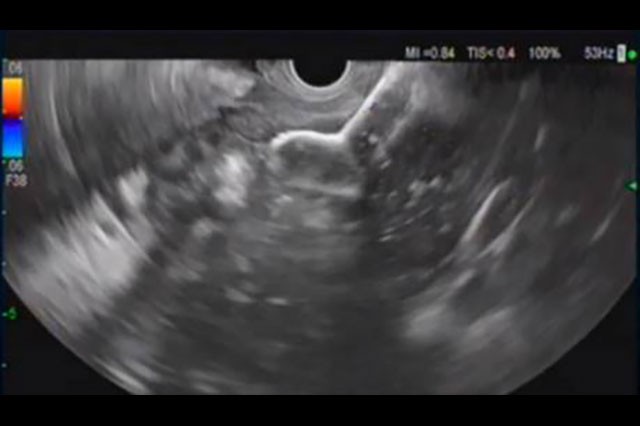A Clinical Discussion of the 20mm AXIOS™ Stent
Prof. Dr. Alexander Arlt
University Hospital Schleswig-Holstein
Kiel, Germany
ACCESS: Describe a specific case in which you feel there were potential clinical benefits of using the larger 20-millimeter.
Dr. Arlt: I'm thinking about a 50-year-old patient who had a biliary pancreatitis four weeks ago. It was a long recovery and a walled-off necrosis. And after the four weeks, the necrosis showed signs of infection. Was a necrosis localized at the corpus of the pancreas with the diameter of 8 centimeter, a high amount of fluid of over 70%, and signs of infection.
So we decided to use the 20-millimeter AXIOS because we were thinking that we need a high number of necrosectomies because of the solid necrosis. And we wanted a stent that is capable of fast and complete drainage of the fluid content because of the infection. And for this patient, we used the 20-millimeter AXIOS stent and had a quite nice drainage of the fluid content and then only had to perform three endoscopic necrosectomies and had a complete resolvement of the necrosis.

ACCESS: And can you tell us about the patient outcome and his recovery?
Dr. Arlt: This patient was followed up for four weeks. And after four weeks, we performed a sonography showing that the necrosis was completely resolved. We took out the stent. And this patient is now for one year in follow-up and had no relapse or no problems specific for the necrosis or the biliary pancreatitis.
Prof. Dr. Rastislav Kunda
University Hospital Brussels
Jette, Belgium
ACCESS: Can you please describe a memorable case?
Dr. Kunda: As coming from a high-volume center, we had numerous patients treated already with the 20-millimeter AXIOS device and lumen-apposing metal stent. There have been multiple memorable cases where we had referred patients from elsewhere, from smaller hospitals or regional hospitals after being on ICUs over the course of six months. And after the insertion of 20-millimeter AXIOS lumen-apposing metal stent, the recovery was fast. And patients got out after these four or six months in ICU, got within a couple of weeks to the normal ward and have been discharged from the hospital over the next three, four weeks.
ACCESS: Describe a specific case in which you feel there were potential clinical benefits of using the larger 20-millimeter stent.
Dr. Kunda: I strongly do believe that in the future, larger lumen-apposing metal stent, larger than 15 and 20 millimeters may have a huge benefit in treatment of infected patients with a higher percentage of infected necrosis within the fluid collection itself. We had multiple patients with fast recovery, where they had been severely infected, in septic status, and they had a vault of necrosis around 60%, 70% and yet they recovered fast while using a 20-millimeter device.
Mouen Khashab, M.D.
Johns Hopkins Hospital
Baltimore, Maryland
ACCESS: Are there any memorable cases that you could describe placing the 20-millimeter stent?
Dr. Khashab: Now the 20-millimeter stent is our go-to stent for management of walled-off necrosis. I do remember a very recent patient who was sick, and he was admitted to our surgical service with infected walled-off necrosis. And the patient was in the surgical ICU, with hypotension and symptoms of systematic inflammatory response syndrome. And because he had infected necrosis, the 20-millimeter allowed immediate drainage with a wide bore at 20-millimeter stent that allowed, again, immediate, fast drainage. And fast and easy access to the cavity to improve outcome. This patient had the initial procedure and then had a subsequent necrosectomy, and that was everything the patient needed. In three weeks, we were able to remove the stent with complete collapse of a 12-centimeter walled-off necrosis cavity. So that tells you even in these patients who presented with these severe symptoms and a large cavity that's infected and full of necrotic material, placement of a 20-millimeter stent did not only allow for complete recovery of the patient, but also fast collapse of the cavity.
ACCESS: Is there another specific case where you feel there were other potential clinical benefits of using a larger stent?
Dr. Khashab: And so other memorable cases include a patient from a few months back, again, infected walled-off necrosis with a high-density material within the cavity. And the placement of the 20-millimeter really helped accessing that cavity, performing the necrosectomy that the patient needed later, and avoiding obstruction of the stent. When a patient has this necrotic material within the cavity, even a 15-millimeter stent can get obstructed by this solid material. The 20-millimeter possibly will decrease the chance of obstruction. So, in these patients, such as the recent patient I just mentioned, my preference now, in 2018, is to place a 20-millimeter stent and avoid patients coming back with an infected pseudocyst or infected walled-off necrosis due to an obstructed stent.
More Perspectives
How Esophageal Stenting is Changing the Treatment Landscape in East Africa
Biliary Stricture Management Algorithm using RFA and Stent Placement
Educare
To explore in-depth physician-led lectures, procedural techniques and device tutorials, visit Educare.
Get started














